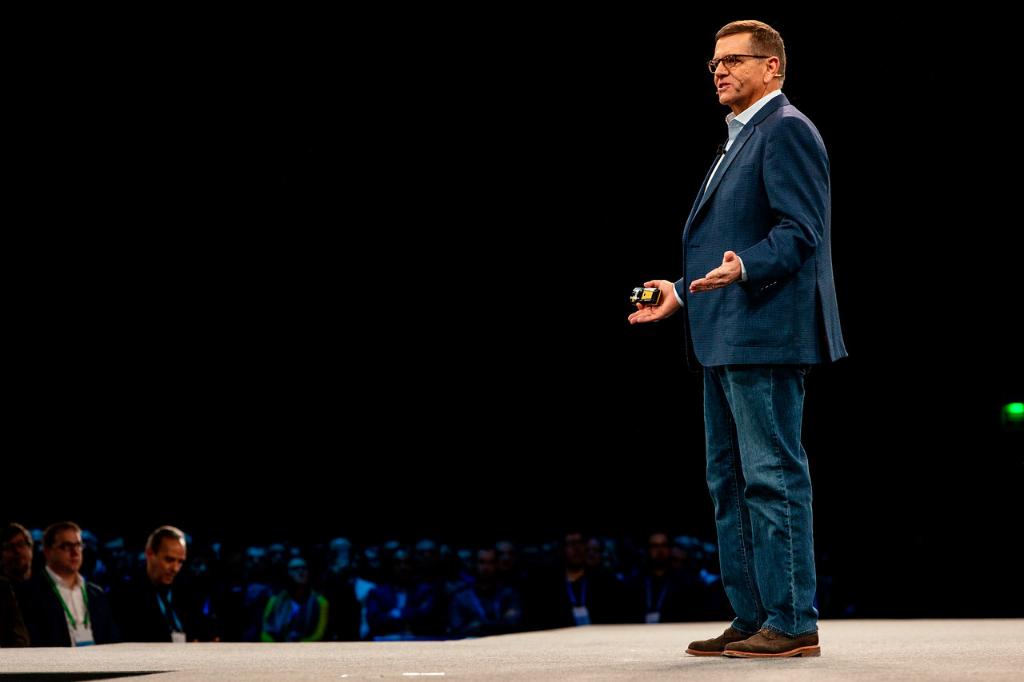 CLOUD
CLOUD
 CLOUD
CLOUD
 CLOUD
CLOUD
It’s “day zero” at Cisco Live EU, and as the pre-gaming dies down, anticipation for the morning keynotes awakens. What will the networking giant announce Tuesday morning from the stage at Fira Gran Via in Barcelona? And what will the news mean for Cisco Systems Inc.’s ongoing efforts to gain relevance up the computing stack as it evolves for a cloud-happy, developer-centric world?
“The cloud business is noisy, and the networking business is under siege,” said John Furrier, co-host of theCUBE, SiliconANGLE Media’s mobile livestreaming studio. “David Goeckeler (pictured), Sri [Srinivasan], and other executives are preparing to announce, rumor has it, some insights into what Cisco’s position will be vis-à-vis cloudification. That’s going to change their portfolio and probably identify some opportunities and also some potential gaps in their strategy.”
Furrier sat down with fellow hosts Stu Miniman and Dave Vellante, broadcasting from Cisco Live EU, to discuss the impact of the public cloud on Cisco’s business and the challenges and opportunities Cisco now faces as the holy trinity of infrastructure — storage, compute and networking — is gobbled up by software. (* Disclosure below.)
Considered one of the four horsemen of the internet era, Cisco was among the few companies to not only survive, but thrive after the first dot-com bubble burst.
“Ten years ago if I thought about Cisco, I’d be looking at the eye pattern of getting the jitter out of the network and trying to tweak everything,” Miniman said. “Today with Cisco, we’re talking about software, we’re talking about cloud, we’re talking about developers.”
Although Cisco remains a networking company at its core, it has been going through a significant transformation. Today, Cisco is a very different company, according to Miniman, who noted Cisco’s prime when it achieved a $500-billion market cap at the turn of the century.
Cisco’s current market cap is about $200 billion, and the company remains a dominant player in switching and routing. But it faces threats, including a sometimes unfocused acquisition strategy and a growing number of rivals providing integrated networking that’s crucial to managing multicloud environments.
Under the leadership of former executive chairman and chief executive John Chambers, Cisco made about 180 acquisitions, which fueled growth, filled in gaps as cloud computing emerged, and kept Cisco relevant with existing customers. And though Chambers was known to say these acquisitions were all going to become billion-dollar businesses, many of them didn’t pan out in the end.
“[Cisco] had to cut and burn, but now under the leadership of Chuck Robbins, they’re a much more focused company, getting back to basics, trying to bet on sure things,” Vellante said.
The manner in which Cisco executes its new products and integrates its most recent acquisitions will determine its long-term success, according to Furrier. Having sustained two-thirds of the networking market over the past decade, Cisco’s software play, grounded in a subscription-based model, presents the biggest opportunity to carry it into the next 10 years.
“Subscriptions is the cloud model that is critical for Cisco now,” Vellante said. “While they say 70% of their software business is subscriptions and annual recurring revenue, it’s unclear really how big their software business is. They give hints — I pegged it at about $78 billion last year, maybe they’ll grow it $10-12 billion this year — pretty sizable.”
Growing these margins to increase free cash flow is critical for investing in stock buybacks and dividends to prop up Cisco’s stock, according to Vellante. However, Furrier warned that chasing one’s tail on stock pricing can be a distraction.
“It’s a balance between cannibalizing your own before you can bring in the new, and this is going to be a challenge for Cisco,” he said. “When they bite the bullet and say, ‘OK, we’ve got to get a position on this piece here or this piece there,’ ultimately, it’s going to be about customers.”
To that end, customers want multicloud management. Thanks to the proliferation of public cloud platforms, such as Amazon Web Services and Microsoft Azure, enterprises live in a hybrid-cloud reality. Furrier sees customers executing specific technologies to meet their operating model’s needs.
The big wave for Cisco, he said, is this multicloud world because it’s not just an approach to technology, but a value proposition.
Here’s the full analysis video, part of theCUBE’s and SiliconANGLE’s coverage of Cisco Live EU. (* Disclosure: Some segments of theCUBE have been sponsored at this event and will be disclosed. No sponsors have editorial control over content on theCUBE or SiliconANGLE.)
THANK YOU